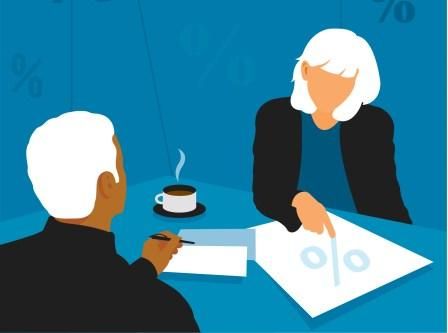
An asset-backed security is an investment that pays based on revenue received from some underlying asset.
While that's typically debt, such as credit card payments or auto loans, they can be built out of just about any revenue source. (Mortgage-backed securities are the same thing under a different name.)
An asset-backed security is an investment that pays based on revenue received from some underlying asset.
For example, movie studios have created bonds around film profits in the past. Debt is more common, though, because payments are regular and fixed, whereas profits off an asset are speculative and variable.
Selling securities also helps lenders finance future loans, which encourages them to sell these products.
Financial institutions that originate loans—including banks, credit card providers, auto finance companies and consumer finance companies—turn their loans into marketable securities through a process known as securitization.
These financial institutions sell pools of loans to a special purpose entity (SPE), whose sole function is to buy such assets in order to securitize them.
The SPE, which is usually a corporation, then sells them to a trust. The trust repackages the loans as interest-bearing securities and actually issues them.

Asset-backed securities, called ABS, are bonds or notes backed by financial ‘securitized assets’ such as mortgages, receivables, student loans, credit card debt, etc.
Asset-backed securities allow issuers to generate more cash, which, in turn, is used for more lending, while giving investors the opportunity to invest in a wide variety of income-generating assets.
read also
- Investment guide: Which stocks and sectors gained the most in the first 100 days of COVID-19 - and which had the most to lose?
- Are offshore bonds truly worth an expat’s hard-earned money? Read to find out!
- UAE expat problems: Finding a retirement plan before settling down!
- UAE: Adapting to the online way of working your finances and investments in a pandemic
- UAE: Ever thought how you could apply probability to your routine investment decisions? Here's how!
ABS are bonds or notes backed by financial ‘securitized assets’ such as mortgages, student loans, credit card debt
Usually, the underlying assets of an ABS are illiquid and can't be sold on their own, which constitute a key risk.
The ABS market peaked in 2007 at $2 trillion ahead of the financial crisis and subsequently began to decline post-crisis, as issuance was greatly reduced.
The market didn’t begin to rebound until 2013, when securitization expanded beyond the traditional categories.

Although the ABS market has experienced considerable growth since the mid-1980s, it remains the smallest subset of the fixed income universe, dominated by treasury, corporate, mortgage-related, municipal, and government debt. (ABS makes up just 4 per cent of the fixed-income market.)
ABS market has had considerable growth since the mid-1980s, but it remains the smallest subset of the fixed income universe
However, it is important to note that small does not mean risky. On the contrary, the ABS market offers investors a chance to diversify by investing in a broad market comprised of a variety of asset types.
Additionally, the manner in which these deals are structured allows an investment manager to determine the level of risk they are willing to assume when investing.
Major types of Asset-Backed Securities
Mortgage-backed securities, auto loans ABS, credit card receivables ABS, student loans ABS, etc. are some major types of asset-backed securities.
The amortizing asset-backed securities which are backed by mortgages are called mortgage-backed securities (MBS) which are further classified into residential mortgage-backed securities (RMBS) and commercial mortgage-backed securities (RMBS).
Mortgages are amortizing loans made for and collateralized by real estate. MBS are a subset of the ABS. Mortgage-backed securities which are issued by government agencies are called agency MBS and other mortgage-backed securities are called non-agency MBS.

• Collateralized Debt Obligation (CDO): A collateralized debt obligation is a type of structured asset-backed security.
Originally developed as instruments for the corporate debt markets, after 2002 CDOs became vehicles for refinancing mortgage-backed securities.
A CDO is a complex structured finance product that is backed by a pool of loans and other assets and sold to institutional investors.
A CDO is a particular type of derivative because, as its name implies, its value is derived from another underlying asset. These assets become the collateral if the loan defaults.
• Auto loans ABS are backed by auto loans and are also amortizing in nature.
• Credit card ABS are backed by credit card receivables and are non-amortizing in nature.
The benefit to the buyer—usually institutional investors—is that they can pick up additional yield relative to government bonds and augment their portfolio diversification.

Asset-Backed Securities: Risks and how they are managed?
There are two main risks relevant to asset-backed securities: credit risk and prepayment risk.
Let’s see what they are about and also how they are effectively managed by most.
• Credit risk is that the risk that the issuer of the asset-backed securities i.e. the special purpose vehicle may default on its payments.

• Prepayment risk is the risk that people will prepay their mortgages in low interest environment thereby returning the principal amount early.
What this means is that there is a chance that investors will experience reduced cash flows caused by borrowers paying off their loans early, particularly in a low-yield environment when borrowers can refinance existing loans at lower rates.
Reality check! Real world ABS problems
While some investors have success with ABS investments, some ABS have historically turned out to be bad investments.
It was the meltdown of ABS holding sub-prime mortgages that initiated the Great Recession that began in late 2007.
While some investors have success with ABS investments, some ABS have historically turned out to be bad investments.
Only financially sophisticated, wealthy investors buy individual asset-backed securities directly.
Evaluating the underlying loans requires considerable research and the process of acquiring the necessary data isn't always straightforward, matter experts and financial planners recommend.

The mixed history of ABS securities suggests that some caution needs to be exercised, even when buying AAA or AA rated ABS (explanation on credit rating in box below).
In the past, it has also been observed the credit ratings attached to ABS by Moody's and other rating agencies have not always been reliable.
The mixed history of ABS securities suggests that some caution needs to be exercised!
So analysts say it's prudent to only buy ABS ETFs from large, highly regarded issuers, such as BlackRock, Fidelity, or Vanguard, and to invest in investment-grade products.
These are assigned by credit rating agencies such as Moody's, Standard & Poor's, and Fitch, which publish code designations (such as AAA, B, CC) to express their assessment of the risk quality of a bond.
AAA ratings are issued to investment-grade debt that has a high level of creditworthiness with the strongest capacity to repay investors.
The AA+ rating is issued by S&P and is similar to the Aa1 rating issued by Moody's. It comes with very low credit risk and indicates the issuer has a strong capacity to repay.
From there, numbers or symbols further break down the letter-based rating.
For example, with S&P and Fitch, a rating of AA+ is better than AA, and a rating of AA- is worse than AA, but better than A+. Moody's uses numbers to indicate relative quality, with Aa1 being the best Aa rating, followed by Aa2 and Aa3.

Let’s recap! How do Asset-Backed Securities work?
Let’s quickly summarize how ABS work and follow it up with an example.
So when a consumer takes out a loan, their debt becomes an asset on the balance sheet of the lender.
And the lender, in turn, sells these assets to a trust or SPE, which packages them into asset-backed security that can be sold in the public market.
Essentially, the interest and principal payments made by consumers ‘pass-through’ to the investors that own the asset-backed securities
Typically, individual securities are gathered into ‘tranches’ or groups of loans with similar ranges of maturities and delinquency risks.
It may create a trust (or SPE) which is typically an entity for making its assets and liabilities separate from the bank in legal sense and transfer the loans portfolio to that trust.
It can dissect the loan portfolio based on their final maturity date and their credit risk and create four difference securities as follows.
The bank will receive the proceeds of the ABS and use them to make further loans.
The asset-backed securities allow investors to access a market which is otherwise not efficiently accessible by them and create more loanable funds. This is how ABS are useful.
But below you will see how during the financial crisis some greedy bankers shorted the ABS they sold - eventually ending up contaminating the entire market and the banking system.
ABS allow investors to access a market which is otherwise not efficiently accessible by them and create more loanable funds.
How the concept of ABS was demonized by greed?
When a group of people took loans from banks to buy houses, banks packaged and sold these loans to investment banks, who then bundled hundreds of these loans and asked the credit rating agency for a good rating and got it.
The ABS product - Collateralised Debt Obligation (CDO) - was hence formed, ready to be sold in the market. Since a CDO had the stamp of rating agencies, investors bought them hoping they would get a good investment yield.
The demand for CDO was rising in the market as these CDOs were nothing but a bundle of home loans, and it was assumed, everyone pays their home loan. So the risk was low.

And these loans had adjustable rates. Meaning that in the initial years, the interest rates would remain low, but later the rates would spike.
But the home buyers had no idea about it. They were happy that they were getting homes to live at a lower initial cost.
After giving loans to people with questionable credit history, the banks sold these loans to the investment banks. The same process of bundling and selling it in the form of CDO was repeated. Everyone was making money.
Since the banks had given out sub-prime loans to a lot of people, there was just far too many houses to auction and not many willing buyers for them.
And these loans had adjustable rates. Meaning that in the initial years, the interest rates would remain low, but later the rates would spike.
With an abundance of such houses and not many buyers, the real estate prices started coming down.

As the loans started defaulting, the values of CDO, which is nothing but a bundle of home loans, also went down.
As the value of CDO came down, investors lost their money. The investment banks had far too many worthless CDOs to sell but no buyers for it.
The banks had too many bad loans to sell to the investment banks, but no takers. The banks had no money, the investment banks were clueless about what to do with CDOs.
The entire financial system came to a standstill as the bank had no money to function or give to others.
ABS in reality are not that bad as a product!
For sure it creates additional liquidity in the banking system, giving banks opportunity to offer excess leverage, resulting asset quality deterioration resulting in impairments and write offs.
But as an investment product, in itself it is not as bad as being made out to be. The failings of 2008 came mostly from greed, poor integrity of bankers and rating agencies.
The global financial crisis demonized the concept of ABS. In reality, they really are not that bad as a product.

Aversion among investors towards ABS?
ABS, particularly mortgage-backed securities can be purchased at most full-service brokerage firms and some discount brokers.
But the most common way to participate in this market is with mutual funds or with REITs that own mortgages rather than actual real estate.
ABS, particularly mortgage-backed securities can be purchased at most full-service brokerage firms and some discount brokers.
The minimum investment is typically $10,000 (Dh36,730); however, there are some MBS variations, such as collateralized mortgage obligations (CMOs), that can be purchased for less than $5,000 (Dh18,365).

Even though the structured credit market underwent a painful yet necessary transformation in the aftermath of the crisis as market participants soberly returned to conservatism, the asset class remains complicated for most non-professional investors.
Due to the costs and inherent risks involved, there is still an aversion seen among many retail investors with not a lot of income to spare, even in the last decade.
But that being said, demand and interest among financial institutions has rebounded post-crisis and is seen going strong as of 2019-end.
Although certain variations of mortgage securities got a black eye a few years ago when they were blamed for bringing on the financial crisis, they still exist and can be found in many fixed-income mutual funds and real estate investment trusts.
Many experts say they're safer now and are worthy of a small part of the ordinary investor's portfolio. Some funds holding non-agency securities yield upward of 10 percent.

ABS, like mortgage-backed securities, can be an appropriate choice for bond investors seeking a monthly cash flow, higher yields than government treasury bonds, generally high credit ratings, and geographic diversification.
ABS, like mortgage-backed securities, can be an appropriate choice for bond investors seeking a monthly cash flow!
Investors who are looking for monthly income might want to explore the benefits of mortgage-backed securities, as they pay both interest and a portion of principal on a monthly basis. This return of principal can then be spent or reinvested in the current interest rate environment.
Historically, mortgage-backed securities have provided yields that are higher than those for Treasuries of comparable maturities. This is mainly due to the uncertain nature of their cash flows and lower liquidity than Treasuries.






_resources1_16a30b358e0_small.jpg)

